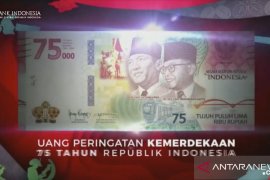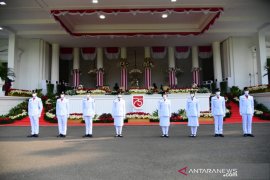This year’s celebrations, however, come with an unexpected yet popular banner.
Instead of simply flying the Red and White flag as usual, some Indonesians have begun raising the Straw Hat Pirates flag, an icon from the Japanese comic and animation series One Piece.
Photos and videos circulating on social media show residents hoisting the fictional flag on homes, vehicles, and in public spaces. Some footage shows the pirate ensign flown beneath the national flag, while other clips show the fictional symbol fluttering alone.
The global popularity of One Piece, now part of worldwide pop culture, easily paved the way for this online trend to blow up as a national sensation just as the country nears its anniversary.
The phenomenon has drawn reactions from top officials and sparked public debates over its legality and the message it is meant to amplify.
House of Representatives (DPR) Deputy Speaker Sufmi Dasco Ahmad took a firm stance, labeling the wave of Straw Hat flags as “a systematic move to undermine national unity.” Nonetheless, he urged people to avoid provocative acts and to welcome August 17 by strengthening unity.
Similarly, Coordinating Minister for Political and Security Affairs Budi Gunawan stressed that flying the fictional ensign might have legal consequences, especially if it disrespects the dignity of the Red and White flag.
He reminded the public that the national flag must be treated with the utmost respect, including prohibitions on flying it beneath other symbols, as mandated by Law No. 24 of 2009 on the Flag, Language, State Emblem, and National Anthem. For compactness, the regulation will be referred to as the National Symbol Law from here onward.
Human Rights Minister Natalius Pigai shared a similar view, asserting that the Indonesian government reserves the right to ban people from flying the Straw Hat flag during Independence Day commemorations.
He believes the international community would not object to such a ban, as it would be solely intended to protect national symbols rather than to limit freedom of expression.
Meanwhile, Deputy Home Affairs Minister Bima Arya Sugiarto took a more lenient position, seeing the trend as a natural democratic phenomenon. He regarded the pirate flag as a new, subtle form of citizen expression or critique of the government, comparable to how Indonesians commonly fly flags representing their groups or organizations.
Nonetheless, he reminded the public that the Red and White flag must always take precedence and be protected from any acts that demean it.
The Jolly Roger
Before attempting to decipher the possible message Indonesians are trying to echo with the fictional pirate ensign, we may agree that the buzz this online trend has created is inseparable from the popularity and longevity of One Piece itself — a series that has yet to hint at an imminent conclusion.
Eiichiro Oda, the author, has worked on the series since 1997, first publishing it as a manga, or Japanese-style comic. It only took the adventurous story two years to be adapted into an animated series, or anime. By the time this article was written, the One Piece manga had reached chapter 1156, while its anime version had gone as far as 1137 episodes.
While Naruto — another phenomenal Japanese story — has ninja groups showing off unique symbols, mostly on forehead protectors, as one of its most memorable features, One Piece plants the idea that pirates are groups who fly a personalized version of the Jolly Roger to represent themselves and their ideals.
Historically, real-life pirates did hoist the Jolly Roger — a kind of ensign typically showing a skull and crossbones on a black background. This symbol was mainly used to strike fear into targeted vessels and signal imminent violent naval encounters.
British journalist Tim Marshall notes in his book A Flag Worth Dying For: The Power and Politics of National Symbols that the use of the Jolly Roger at sea dates back to at least the 18th century. Captain John Cranby of the Royal Navy ship HMS Poole recorded in his log that a French pirate vessel sailing off Cabo Verde in West Africa in July 1700 bore a black flag with “crossbones, a death’s head, and an hourglass.”
In the following decades, rogue ships adopted the Jolly Roger with varied designs and compositions. There was no single, universal version of the flag, but pirates and sailors alike understood that a black background signaled threats, allowing targets to surrender, while a red background meant no quarter would be given.
In the One Piece universe, however, pirate flags diverge from this historical interpretation. In the series, pirates modify the Jolly Roger freely, usually adapting the skull with unique traits directly reflecting their captains.
Message, not menace
One Piece Jolly Rogers basically represent the pirates they belong to, rather than serving as a symbol to convey fear and terror.
As mentioned earlier, the viral trend in Indonesia mainly features the Straw Hat Pirates’ Jolly Roger — a black flag emblazoned with crossbones and a grinning skull wearing the iconic straw hat of the captain, Monkey D. Luffy.
Although Oda has not officially assigned a deeper lore to the flag, fans generally believe it symbolizes the crewmembers’ hopes and dreams, and their will to live freely.
This interpretation has seemingly seeped into and resonated with Indonesia’s One Piece flag phenomenon, as seen in responses shared by Indonesians on social media. Finding netizens linking the trend to people’s dissatisfaction with the government is nothing but a piece of cake.
Those rallying behind the trend argue that the Straw Hat flag perfectly represents people’s opposition to perceived corrupt and unjust practices among officials. This belief is rooted in the fact that throughout their voyages, the Straw Hat Pirates often clash with oppressive powers, including the World Government — the supreme, supranational, oligarchal authority in the series.
It is also worth noting that netizens have begun defending both the trend and the national flag with sharper tones, such as saying, “The Red and White flag is too pure to fly on this land.”
Whatever exact message people intend the flag to convey, it is rather safe to say this online phenomenon has emerged as a wake-up call for the Indonesian government to work harder to earn public trust, address their concerns, and take concrete steps toward a brighter future for the country as it approaches its eight-decade mark.
Seizing opportunity
Top officials noticing this trend alone is further proof that a simple symbol on a humble sheet of cloth can move the masses — or, in Tim Marshall’s words, flags "wield a great deal of power, communicating ideas quickly and drawing strongly on emotions.”
After all, Indonesia has no legal instruments blatantly restricting citizens from displaying benign symbols as a way to exercise their right to freedom of expression. As Deputy Minister Sugiarto said, hoisting the One Piece flag in protest of the government does not constitute a crime — it is simply part of democracy.
The National Symbol Law does address proper treatment of the Red and White flag, but it does not explicitly ban fictional flags from flying in the country.
Looking at it through a more optimistic lens, this online phenomenon can be seen as an opportunity for the Indonesian government not only to reassure the public about their right to expression but also to highlight the National Symbol Law itself.
While the law is not directly linked to the fictional flag, this trend is the right moment for the government to raise awareness about the regulation — reminding people that the Red and White flag is entitled to certain protocols.
Article 24 of the law lays out several restrictions on the use of the national flag, including hoisting it in a damaged, torn, faded, crumpled, or dull state; defacing it with other symbols; or using it as packaging for goods or other commercial purposes.
Promoting these provisions is especially important to ensure that citizens who join the festivities of the 80th independence anniversary treat the Red and White flag with proper respect, including ensuring the national flag is not flown beneath the One Piece flag, as this could be considered offensive.
In a nutshell, the wave of Straw Hat flags sweeping Indonesia as it approaches its 80-year milestone reflects the people’s care and hopes for the country — an expectation for the nation to steer itself toward a better path.
At the same time, this trend presents an opening for the government to reaffirm its commitment to progress and to remind the public how vital it is to treat the national flag with utmost respect, especially as the country once again transforms into “a sea of Red and White.”
Editor: Aditya Eko Sigit Wicaksono
Copyright © ANTARA 2025












